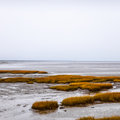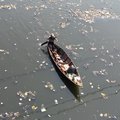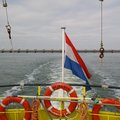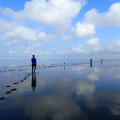Archive
01 February 2020
What the Wadden can teach us

Intertidal zones are crucial for the protection of our coast and as stop-overs for migrating birds. But, increasingly, many of these sand and mudflats are disappearing permanently underneath the waves. Cynthia Maan investigated how by cooperating with nature and using a systems-based approach these precious resources can be saved.
31 January 2020
New staff member: Hassan Niazi

We warmly welcome Hassan in our department! Click here to read his introductory words.
30 January 2020
MSc Thesis proposal
Building with Nature Solutions in Flood Defenses. Looking for a student to start straightaway (early 2020).
25 January 2020
Plastic-free Rivers

The oceans of the world are filling up with plastic waste carried there by rivers. Where it all comes from no one knows. Wim Uijttewaal, professor of Experimental Hydraulics and professor of Resources & Recycling Peter Rem are on a mission to make the rivers plastic free. ‘We want to turn the removal of plastic from rivers into big business. And we want to devise a plastic waste radar that will show where the plastic is, and how it got there.’
11 January 2020
Storm at sea: the inside story

A subject of rollicking sea shanties the world over, storms at sea have always fired people’s imaginations. But knowledge of what happens underneath the waves is not quite as universal. Femke de Jong, Caroline Katsman and Carine van der Boog are preparing to don their sou’westers to investigate the inside story.
29 December 2019
The turbulent waters of the Eastern Scheldt

Whenever there is a problem with the Eastern Scheldt storm surge barrier, the Dutch get worried. The last time the barrier made the news was in 2013, when the stability of the barrier’s foundation protection was compromised.
25 December 2019
The Wadden Mud Motor project: making nature do the work

The tidal flats of the Wadden is where land and water meet. This natural environment has become familiar territory for researcher Bram van Prooijen and PhD Irene Colosimo, who both work at TU Delft’s department of Hydraulic Engineering. It’s where they are carrying out the Mud Motor project hoping it will provide them with the answer to a vital question: how to make nature work for us in such a way as to preserve the Wadden coast in a sustainable way.
22 December 2019
Follow the pretty pebbles

Rivers meander: it’s what they do. They make their way through the landscape twisting and turning as they flow. In the Netherlands a meandering river has become a rarity. ‘Many rivers worldwide have been ‘humanised’,’ says Victor Chavarrias who is researching rivers, with the Rhine as his case study. ‘200 years ago the Rhine meandered strongly. That made life in the floodplain dangerous and the transportation of goods very inefficient. To overcome these difficulties in the 19th century they started cutting the bends and narrowing the river with the construction of groynes.
17 December 2019
Building offshore wind turbines quickly and gently without disturbing marine life

How can you build foundations for offshore wind turbines creating as little disturbance as possible?
14 December 2019
Mangroves caught in the middle

In a channel at TU Delft’s Water lab a stream of purple-tinted water makes its way past thousands of small wooden pegs. The water was dyed by PhD-candidate Son Truong Hong, who is closely observing the flow with an empty bottle of paint in his hands. This test forms part of his research into the importance of the mangrove forests in the Mekong Delta estuaries. Son is fascinated by the tangled roots of these extraordinary trees. What is the mangrove’s role in preventing river bank erosion? And, most crucially, how much of the mangrove forests needs to remain to support a healthy ecosystem?